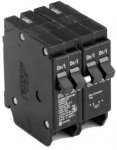JDBrown
Senior Member
- Location
- California
- Occupation
- Electrical Engineer
The other day I came across a circuit breaker feeding a residential dryer that was marked "Independent Trip." I know that when I specify 2 pole breakers for 240V appliances, I always ask for common trip, but this is an existing installation. I'm trying to figure out if this is something I should recommend they replace, or if it's no big deal. With it being a dryer, I don't think there's a problem, because all the dryers I've ever seen have a 120V motor anyway (so no need to worry about "single-phasing" the motor). IIRC, the heating elements are also 120V -- the only reason the dryer needs 240V is to allow for more heating elements. But I'm not 100% certain that this is true of ALL electric dryers in the US.
By my reckoning, if only one pole of that breaker trips, you might lose any combination of: electronic controls, motor, and/or half of your heaters. I think this could cause a fire hazard if one of the heaters stays on but the drum and vent fan/blower are not spinning. On the other hand, it would probably take a pretty special set of circumstances to make that happen, and for all I know dryers might be required to shut down if they lose one phase anyway.
I have four questions that have come out of all this:
By my reckoning, if only one pole of that breaker trips, you might lose any combination of: electronic controls, motor, and/or half of your heaters. I think this could cause a fire hazard if one of the heaters stays on but the drum and vent fan/blower are not spinning. On the other hand, it would probably take a pretty special set of circumstances to make that happen, and for all I know dryers might be required to shut down if they lose one phase anyway.
I have four questions that have come out of all this:
- Is there a Code violation here?
- Is this installation unsafe?
- Are there any other issues with the existing installation that I might have missed?
- Would you recommend replacing the breaker with a common trip type?


